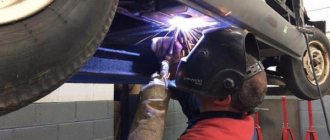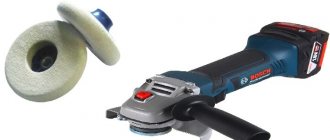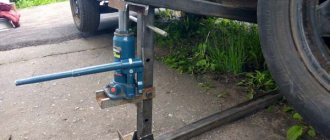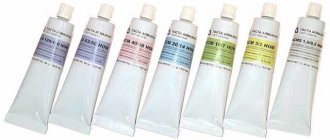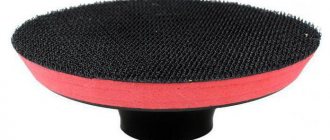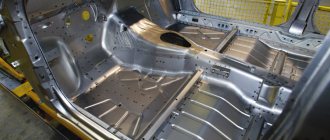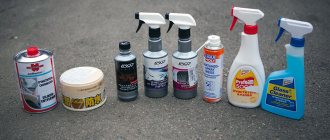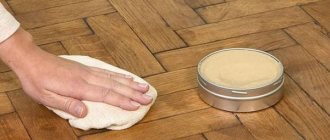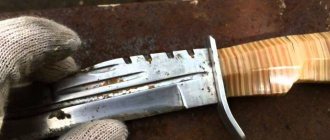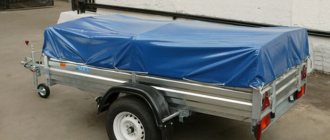The owner cares about the presentability and beauty of the car no less than problems with the electronics or engine, so polishing the car body is done carefully and regularly. A properly selected polishing attachment for a drill will be able to carry out the work carefully, ultimately obtaining an excellent result.
A properly selected drill attachment can perform the job carefully.
Assortment of attachments
The most common products for processing automobile bodies are: sponge-like, abrasive with varying degrees of grain, felt, having a soft surface. They are conventionally classified according to the type of production into two types:
- petal (has high productivity and high price);
- surface grinding (made like a rubber disc with an additional coating for processing).
The material for these items is dense foam rubber or felt, which has different diameters. However, kits are sold that consist of several elements that have different purposes and manufacturing complexity.
Making your own nozzles
If there is no suitable option on sale, then for a disk with a high level of rigidity you can make a soft layer of great thickness and place it between Velcro and a plastic base. Using a utility knife, you need to cut off the Velcro where the soft layer will be glued. For the soft layer, a bath sponge is mainly used. It must be remembered that individual elements can shift, breaking the overall symmetry.
You can also use a felt disc, which is used in a polishing machine and machine. First, you should make a pin with a suitable diametrical size and apply a thread on one side. On this side you need to secure the disk, which is surrounded on both sides by a wide nut and a limit washer. This device is not difficult to manufacture and can be used to process various surfaces.
Application nuances
A drill attachment for car polishing can be purchased at any store that sells car products. However, you should choose these devices carefully.
Body elements of new cars are made using modern technologies. An anti-corrosion compound and paint are applied to the metal, which are wear-resistant. They will last approximately 15 years. However, this coating is better preserved if it is properly cared for. The polishing device restores the original shine and removes defects from the surface. Together with a special product, such a product will cost less than services provided in a workshop.
Communities › Moidodyr › Blog › Abrasive Polishing with Drill
Apparently, for more than four years of use, my Olympic Gold was never polished and the paintwork of the body lost its original shine and acquired quite a few small scratches. I was not going to give my Gold to a service center for professional polishing, because they asked for a full body polishing of 10K rubles.
I watched quite a few videos on YouTube and re-read a huge number of entries on Drive and decided that anyone can polish the body of their car, including me.
In general, whenever possible, I try to do everything in my car with my own hands, be it washing, soundproofing, installing music, etc. In general, wherever there is an opportunity to do something myself and there is a desire (and there is always one), I do it myself, because... I’m sure that no one but myself can do it better... And so I went shopping and bought everything I needed.
The consumables I needed were:
The most convenient tool for polishing is considered to be a professional polishing machine, which differs from a regular grinder only in the presence of a speed controller and a comfortable handle, but its cost is several times higher. True, there are several other tools that can also be used to polish a car body. The only tools I had were an eccentric sander and a regular drill with a speed controller. Of course, you can also polish the entire body by hand, but this will take a lot of time and effort, and the result may not satisfy you.
After working a little with an eccentric sander, I decided that I would still use an old drill with a special attachment.
I prepared everything I needed and went to thoroughly wash the car.
A special product helped me a lot from insects and heavy dirt that was not washed off during washing.
There were quite deep scratches on my body, so it was decided to first use a hard felt circle (in the second photo No. 1) with Farecla G6 abrasive polishing paste (in the first photo No. 3)
The first step is to apply Farecla G6 professional polishing paste (No. 3 in the first photo) to a part of the body and try to rub it evenly over the body area (preferably with your hands). Next, we take a drill, set it to 1200-1800 rpm and put on an attachment with a hard felt circle (no. 1 in the second photo). We begin to carefully rub the polish with horizontal and then vertical movements of the drill. I recommend polishing any sharp transitions, moldings, bumpers, corners by hand, because due to lack of skill you can overdo it and gradually, on these weak spots you can get to the paint! Therefore, I apply polish to large areas and polish with a drill, and the rest of the areas manually, with a special cloth.
Source
Body polishing
The polishing process can correct only some defects.
If there is corrosion, chips or damage on the body through which the steel frame is visible, then a major repair will be required. Before starting the polishing process, you should carefully inspect the vehicle to ensure that any imperfections can be eliminated.
Treatment of the body with a special device will give a positive result if:
- slight difference in shades that resulted after partial coloring;
- the presence of roughness, scratches and cloudy stains;
- faded layer of paint;
- the appearance of graininess and streaks of enamel.
You need to know that you can’t overuse polishing, because when you do it, the paint layer becomes smaller by 5 micrometers. From the date of manufacture of the vehicle, no more than 20 polishing procedures can be performed. At this time, you need to use a thickness gauge, especially if the car is used.
Using a polishing wheel
By using a polishing wheel on a drill, you can update the appearance of your car. This procedure is most effective if you need to smooth out small chips or remove tarnishing of the surface.
The work is carried out in 2 stages:
- removing paint from the body surface;
- applying polishing compound.
Protective treatment is also carried out to reduce the negative effects of various types of precipitation and ultraviolet radiation. It is mainly done when preparing a car for sale. A protective layer (it contains wax or silicone) is distributed over the surface of the body to form a film that is invisible to the eye, repels moisture, and makes the body shiny. You can polish a used car with a soft pad if there is no paint damage. It can also be used with careful treatment with a protective agent.
Materials for car body processing
To carry out the car processing procedure, the following materials are needed:
- foam;
- sandpaper;
- grinding compound;
- bike;
- polish.
The product that will be used to treat the body surface must be selected carefully.
A paste containing abrasive particles is needed to remove the top layer of varnish. It must be selected depending on the type of cracks and chips present on the body. A product with a large number of particles is necessary if the defects are very noticeable. Nowadays there is a large assortment of drugs on sale that add brightness to color. The protective coating of a new car may develop cloudy streaks. In such a situation, a restorative paste containing a grinding additive will be sufficient.
A variety of tools allow you to solve any problem. For vertical surfaces it is convenient to use a thick paste. It can be used to process any part of the machine. It is often added to components that increase the brightness of the color.
Why do you need to polish a car body?
Polishing is the process of rubbing a car body with special lubricants that protect the paintwork and remove minor scratches. In order for the car not only to be clean, but also to shimmer in the sun, it is necessary to regularly carry out polishing operations. These operations allow you to solve a number of the following problems:
- Avoid premature destruction of the paint layer
- Protect the body from corrosion
- Make the paintwork shiny, which allows you to effectively highlight your car
- Remove minor scratches and abrasions of the paint layer
To carry out polishing operations, you will need the following set of tools and consumables:
- Power tool - this can be an angle grinder or grinder, drill, screwdriver, eccentric or polishing machine. When using an angle grinder to polish a car body, you need the tool to have a speed control option
- Car polishing nozzles are special devices made of soft materials, through which polishing paste is rubbed into the paint layer of the body. Exactly what types of nozzles for car polishing there are, how they differ, and for what purposes they are intended, is described in detail in the material
- Adapter, mandrel or plate - a device onto which the polishing attachment is attached. Such adapters have appropriate fasteners for installation in the chuck of a drill, screwdriver or on the spindle of an angle grinder and polishing machine. The adapter is used for removable drives, but there are also non-removable devices. They are less popular because they are more expensive. Fixed nozzles are equipped with fastening elements and therefore do not require the use of adapters. It is important to note that the plates are available in diameters of 115, 125 and 150 mm. In addition, they can have a hard and soft base on which a polishing disc is attached. The soft layer on the plate eliminates the beating effect (the vibrations of the power tool are smoothed out), which is especially important when working with sheepskin attachments
- Polishing paste is a consumable material that protects the paintwork of the body, removes scratches, and also achieves shine.
How to polish a car with a drill?
It is not advisable to polish with a drill on a hot day if the work takes place outside. The paintwork can get hot, so you need to park the car so that the sun's rays do not fall on it.
Work process:
- The body must be treated with any means that dissolves fat, and polishing paste must be applied to the surface in small portions. It is best to start work from the trunk and move towards the hood.
- First, a felt circle will do. Place the car polishing attachment on the drill and set the tool to 1300-1700 rpm, moving in horizontal and vertical lines. Do not press the drill too hard, otherwise there is a risk of damaging the paint or acrylic coating.
- Remove any remaining polishing agent with a damp sponge or cloth.
- Next, you can begin soft polishing with a foam pad.
At the end of the polishing process, apply a finishing agent and wipe it with a dry microfiber cloth.
Types of polishing work
First, let's understand that car polishing is classified into two main types of work:
- Protective - such operations allow you to ensure reliable protection of the paint layer from minor mechanical stress, abrasions, and even to avoid the varnish losing its characteristics. Pastes used for rubbing car bodies include substances such as Teflon, wax, etc.
- Restoration is the most common type of work in which car owners resort to polishing the body of their car. They resort to restoration work to remove minor scratches and other types of deformation of the body paint, for example, paint fading in the sun. The principle of restoration work is to remove the top oxide layer. For this purpose, special types of polishing pastes are used. After carrying out restoration work on polishing the body, it is imperative to rub the body with protective paste
You need to decide on the type of polishing work in order to choose the right attachments. After all, the quality of work depends not only on the substance used, rubbed into the body, but also on the material from which the nozzle is made.
Types of car body polishing
- Restorative. It is carried out to eliminate small scratches that have a shallow depth. If damage to the paint layer occurs before the primer itself, then polish will not help. Restorative polishing can remove various abrasions, streaks and stains. The work involves mechanically removing the thinnest layer of coating using abrasive pastes. During the work, about five microns are removed, but there is a clear dependence on the grain size of the paste. This is not much for the original factory coating, since the thickness of the varnish and paint can be from 100 to 150 microns. Most often, this type of work is used before selling a used car to give it a marketable appearance. Let us add that restorative polishing should not be used too often, since it can be sanded to such an extent that places where the primer can be seen through the paint will be visible.
- Protective polishing . Produced to protect the body from adverse environmental influences. This type of polishing work is carried out without the use of abrasive pastes. It is carried out using a non-abrasive polish created on the basis of synthetic substances and various types of waxes. During body work, the paint layer is not removed at all. Protective polishing is ideal for new cars to protect the car body from minor damage.
The period of time during which protection will be effective depends on the composition of the mixture. For example, a protective layer applied with a polymer polish protects the car body for at least six months, and one based on silicone or wax – for several months. But if you apply a polymer polish, it will require more time and appropriate special equipment.
What types of nozzles for polishing a car body are there?
Depending on the type of polishing work, it is necessary to use appropriate attachments. When using protective pastes, delicate nozzles are used, and if it is necessary to remove scratches and abrasions of the paintwork, you will need to use abrasive devices. The polishing procedure can be carried out using drills, screwdrivers and grinders. To do this, it is not at all necessary to buy special polishing machines. Only when using the power tools in question, one detail needs to be taken into account - they must have a speed control function.
Now let's look at the types of polishing attachments for cars. They are made from different materials, but the most popular are foam and sheepskin attachments.
Fabric polishing pads
Cloth attachments are used primarily for manually rubbing polishing paste into the paintwork. An example of hand-held attachments made of fabric is shown in the photo below.
This is interesting!
You can perform initial and final polishing of the car body with foam rubber discs, but it is impossible to perform these procedures with sheepskin attachments. After processing the sheepskin equipment, you need to use soft foam discs.
Felt or felt polishing supplies for car
Felt or felt - felt tips are extremely rare. They are intended for cleaning the body surface before polishing, as well as at the final stage of using polish. Felt nozzles are characterized by increased softness, and they are available in cylindrical and flat shapes. They are not suitable for cases where it is necessary to remove minor defects on the car body. They are used with a drill, screwdriver and grinder that has a speed control function. Their disadvantage is that due to the dense base, the car body heats up.
Sheepskin nozzle for car polishing and its types
Sheepskin attachments for drills and screwdrivers are used to apply a protective layer of polishing paste, as well as remove scratches and other defects. For this purpose, sheepskin equipment is available in different types - regular or classic pile, natural sheepskin, and also twisted pile.
Many people mistakenly believe that sheepskin is intended for finishing or for applying a protective layer. However, this is not at all true. They are intended for starting treatment and removing scratches. After their use, small marks remain, so they are not suitable for finishing. That is why, after using sheepskin equipment, it is necessary to use foam rubber attachments. The length of the pile of sheepskin nozzles ranges from 25 to 40 mm, and the larger their size, the better the cooling.
- Classic sheepskin.
The use of classic sheepskin devices makes it possible to achieve a special shine of the paintwork, which is why they are often used at the final stage for almost all car models, from domestic to foreign cars. - Twisted pile.
With twisted pile, sheepskin is intended for rough or aggressive polishing, that is, when it is necessary to remove small scratches and other paint defects - Natural sheepskin for delicate processing.
The equipment is made of natural sheepskin, which is yellow in color, provides the most gentle effect, and is used for finishing. Typically, devices made from natural sheepskin are used to process German-made cars - BMW and Mercedes-Benz. They differ from the first two options in their high cost, which is due to their production from the wool of rare animals
All types of sheepskin polishing equipment are designed to operate at speeds from 400 to 1500 rpm. This speed mode ensures their maximum efficiency and productivity.
How to polish with a drill
To polish with a drill you will need the following accessories and materials:
The polishing itself is carried out in several stages. In the first stage, deep scratches are removed using a hard felt wheel and abrasive paste. The rotation speed of the drill is set to about 500 per minute and gradually increases to 1500 revolutions per minute.
Then the car needs to be washed again, dried and a layer of finishing polish applied using a foam sponge. At this stage, the drill speed should be increased to 2500-2800 rpm. The remaining polish should be removed from the body with a rag and the car should be washed again. The polishing process can now be considered complete.
Foam polishing attachments types and purposes
Foam nozzles are used not only for applying protective, but also restorative polish at the finishing stage. Manufacturers produce foam nozzles in a wide variety. The foam base differs in the size of the cells, and the smaller they are, the correspondingly softer the effect. To remove small scratches from the car body, you need to use foam rubber attachments on a drill and a screwdriver with large cells of increased rigidity. Different colors of foam nozzles allow you to accurately apply the appropriate pastes.
Foam nozzles are available in two types - petal (with a grooved base) and flat. They differ not only in appearance, but also in the quality of surface treatment. Flat ones carry out the same type of surface treatment, while petal ones, due to their protrusions, allow for delicate processing due to the small area of their contact. Corrugated ones are used for applying wax, as well as removing holograms - small marks on the paintwork. The advantage of corrugated tools over flat ones is that they do not heat up the surface being treated too much.
Which is better: buy a professional machine or use a drill?
Of course, having a special polishing machine will make the process of removing scratches from the body more convenient and faster. But, unlike a drill, the scope of alternative uses of a specialized tool is very limited. At the same time, the cost of a more or less high-quality device starts from $100.
In this regard, in order to polish your car from time to time, a good drill that meets the above requirements will be quite enough. If there are several cars in the family, including relatives, that regularly require polishing, then purchasing a grinder will be justified. The savings from 1 car polishing yourself will approximately correspond to the cost of the tool.
Thus, every car owner can maintain the car body in decent condition. At the same time, it must be remembered that polishing reduces the thickness of the car's paintwork. Therefore, after 4 polishings, it is recommended to repaint the car, which costs completely different money.
Source
What are the pros and cons of car polishing attachments?
Knowing what types of polishing equipment for car bodies are produced, it will be important to consider their advantages and disadvantages. First, let's look at the advantages and disadvantages of foam discs.
- Foam rubber wheels for cars have disadvantages such as heating the surface being treated and high paste consumption
- The advantages of such devices include a wide variety of choices and affordable prices.
For comparison, let's look at the pros and cons of sheepskin attachments for polishing a car:
- Pros: effective in removing scratches (even the largest ones), they do not consume a lot of paste, which means they have low consumption. In addition, such discs do not heat the surface, which is very important when polishing by beginners.
- Disadvantages - they do not allow for finishing, as they leave small scratches and holograms. In addition, their price is higher than foam rubber, and there is little choice
Based on the advantages and disadvantages of both types of polishing attachments, we can draw a conclusion about which types should be chosen in specific cases.
Pros and cons of polishing with a drill
This operation will help get rid of minor scratches, ensure better drainage of water and dirt, and protect the metal of the body from the effects of negative environmental factors.
But polishing services are quite expensive. Therefore, many car enthusiasts prefer to perform this procedure independently. The most affordable option is to use a conventional drill. The advantages of this method include:
This method also has disadvantages. These include:
How to choose a car polishing attachment
You can perform high-quality polishing of a car body not only in a specialized car service center, but also at home. The quality of the work largely depends on various factors, but one of them is the choice of the appropriate nozzle. When choosing polishing attachments for a drill, screwdriver or grinder, you need to consider the following factors:
- Manufacturer and price - if you set out to produce high-quality polishing of the car body, then you need to approach this issue with the utmost rigor and seriousness. Buying cheap little-known attachments or without a manufacturer’s name at all is dangerous because you will not only not be able to get the desired result, but will also ruin the paintwork. That is why it is better not to save money and choose equipment from well-known manufacturers such as 3M, Mirka and others
- Purpose - it all depends on what goals you are pursuing. For protective polishing, soft nozzles are used, and to remove scratches and other defects, abrasive nozzles with a high degree of hardness are used. To polish car headlights, completely different types of attachments are used, so you should not combine them and make them universal
- Speed of work - this factor also needs to be taken into account, since failure to use the equipment at speed will lead to the fact that you can “burn out” the paintwork of the body. On the nozzles, manufacturers indicate the recommended speeds for their use, which also determines the choice of a suitable power tool for the job.
- Size or diameter. Round nozzles are produced with a diameter of 115 to 150 mm. It is important to take this value into account if you plan to carry out work using an angle grinder or a grinder. If a drill or screwdriver is used for polishing, then it does not matter much what size the adapter and working equipment are. The larger the diameter of the equipment, the higher the processing speed, however, it is not recommended for a beginner to buy a device larger than 125 mm, since the processing procedure becomes more complicated due to high vibrations and the need to control the surface being processed
- Type of nozzle - they are removable and non-removable. They differ only in price. Beginners are recommended to use removable attachments, as they allow polishing with quick replacement of attachments.
There is no clear answer to which nozzles are best to use for polishing a car body. To achieve the result, you will need to buy a set of appropriate equipment. However, purchasing such a set is not a guarantee that the work will be done with high quality. Pay attention to what types of polishing pastes for cars there are, and how to choose them (link). To polish hard-to-reach places, for example, cast car wheels, specially shaped equipment is used - cylindrical, conical and others.
To summarize, it should be noted that before polishing a car body for the first time, you must first practice on other surfaces. The wrong choice of nozzle for roughness, as well as rotation speed, will lead to immediate damage to the paintwork. That is why it is very important to be responsible when choosing power tools, polishes and attachments for polishing a car.
Some features
In any case, protective polishing is easier to implement and more economical than restorative polishing. Therefore, if you purchase a new car, you should immediately polish it, without waiting for paintwork defects to appear.
Polishing loses its properties with use and comes off the body, and it is necessary to periodically renew it. To achieve the longest possible service life, it is necessary to follow the operating precautions specified by the manufacturer in the instructions for each polishing mixture.
Apparently, for more than four years of use, my Olympic Gold was never polished and the paintwork of the body lost its original shine and acquired quite a few small scratches. I was not going to give my Gold to a service center for professional polishing, because they asked for a full body polishing of 10K rubles.
I watched quite a few videos on YouTube and re-read a huge number of entries on Drive and decided that anyone can polish the body of their car, including me.
In general, whenever possible, I try to do everything in my car with my own hands, be it washing, soundproofing, installing music, etc. In general, wherever there is an opportunity to do something myself and there is a desire (and there is always one), I do it myself, because... I’m sure that no one but myself can do it better... And so I went shopping and bought everything I needed.
The consumables I needed were:
The most convenient tool for polishing is considered to be a professional polishing machine, which differs from a regular grinder only in the presence of a speed controller and a comfortable handle, but its cost is several times higher. True, there are several other tools that can also be used to polish a car body. The only tools I had were an eccentric sander and a regular drill with a speed controller. Of course, you can also polish the entire body by hand, but this will take a lot of time and effort, and the result may not satisfy you.
After working a little with an eccentric sander, I decided that I would still use an old drill with a special attachment.
I prepared everything I needed and went to thoroughly wash the car.
First, you need to wash the car clean, wipe it from all kinds of dirt, and identify places that require grouting. Deep scratches, cavities, orange peel, paint smears, etc.
A special product helped me a lot from insects and heavy dirt that was not washed off during washing.
There were quite deep scratches on my body, so it was decided to first use a hard felt circle (in the second photo No. 1) with Farecla G6 abrasive polishing paste (in the first photo No. 3)
The first step is to apply Farecla G6 professional polishing paste (No. 3 in the first photo) to a part of the body and try to rub it evenly over the body area (preferably with your hands). Next, we take a drill, set it to 1200-1800 rpm and put on an attachment with a hard felt circle (no. 1 in the second photo). We begin to carefully rub the polish with horizontal and then vertical movements of the drill. I recommend polishing any sharp transitions, moldings, bumpers, corners by hand, because due to lack of skill you can overdo it and gradually, on these weak spots you can get to the paint! Therefore, I apply polish to large areas and polish with a drill, and the rest of the areas manually, with a special cloth.
It is important for a car owner to monitor not only the technical condition of the car, but also its appearance. To put the car body in order, you need to not only wash it with shampoo and wax, but also pre-polish it. Owners resort to polishing the car body not only to give the car a presentable appearance, but also to protect the paint layer from destruction. Polishing is also done to remove small scratches on the paintwork. The type of nozzle for polishing a car determines how to obtain a high-quality result, so let’s look at their types and features of use.
